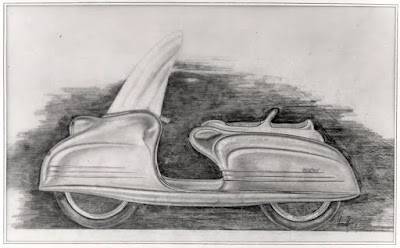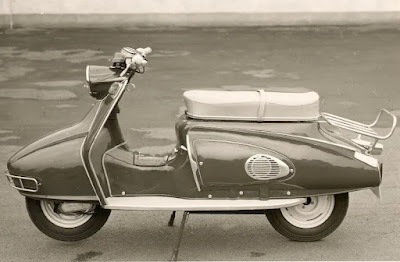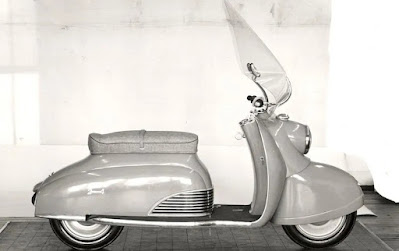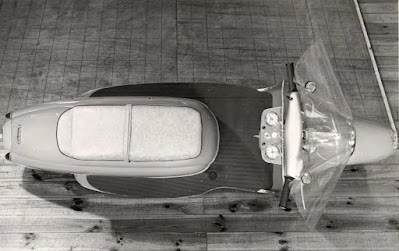Forgotten ONES - Motorcycles and scooters have long been symbols of freedom, efficiency, and design ingenuity. As transportation evolved, manufacturers continually sought to create vehicles that were not only functional but also aesthetically appealing and innovative in their technology.
 |
| In the early 1950s, DKW, already a well-known name in the two-wheeled vehicle industry, gained further recognition through models like the 1955 DKW Hobby scooter. (Picture from: CaClassicScooter) |
 One such brand, DKW, has left an undeniable mark on the world of scooters. Their models, while sometimes forgotten or left unproduced, hold a special place in the history of motor vehicle design. The prototypes and designs that never saw mass production often spark curiosity among enthusiasts and historians alike.
One such brand, DKW, has left an undeniable mark on the world of scooters. Their models, while sometimes forgotten or left unproduced, hold a special place in the history of motor vehicle design. The prototypes and designs that never saw mass production often spark curiosity among enthusiasts and historians alike.  |
| DKW introduced its “Hobby” scooter in October 1954; it differed from its rivals in this category by its large 16-inch wheels and continuously variable automatic transmission. (Picture from: CaClassicScooter) |
 |
| This scooter design dates from 1952 and appears more modern than the DKW Hobby scooter that was actually produced of the time. (Picture from: DKW-AutoUnion.de) |
As time has passed, the fate of these prototypes remains a mystery, leaving many to wonder where they ended up and how close they came to becoming iconic vehicles of their time.
1. Komet R175
The first of these prototypes, the Komet R175, was developed in 1955. This scooter was ahead of its time, featuring an electric starter, a 4-speed manual transmission, and 10-inch wheels capable of reaching speeds up to 90 km/h. Such specifications were quite advanced for the era, making the R175 a promising candidate for production.
It was built with a full swing-arm chassis and disc wheels, which contributed to its smooth handling. Unfortunately, only one rear shock absorber was included, possibly limiting the vehicle's ride comfort. Despite the promising design, the R175 never made it past the prototype phase.
2. Komet R150
Another scooter in the DKW lineup was the Komet R150, which emerged as a concept in 1957. Initially, the design team crafted plasticine models for the planned DKW Komet R150 in 1:2.5 scale were created in a wooden cooy. The R150 was designed with a 150 cc engine, an electric starter, and a self-supporting structure. Its lightweight frame, weighing around 100 kg without the starter, was another feature that set it apart from competitors.
Equipped with a 4-speed manual transmission and capable of reaching speeds up to 80 kph, the R150 seemed poised for success. In 1958, it was priced at 1400 DM, making it an affordable option for many consumers. However, the design, particularly the license plate holder and side panels, underwent significant changes during development, reflecting the futuristic approach that DKW was known for. Despite these efforts, the R150, like its predecessor, was never mass-produced.
3. Komet R200
Perhaps the most intriguing of the DKW scooter prototypes was the Komet 200, also known as the R200. This model saw the development of four different variants, each with unique characteristics. The body of the R200 drew inspiration from DKW's car designs, specifically the DKW F93. The instrument panel of this scooter was particularly advanced, featuring three displays: an ammeter, a speedometer, and a clock.
Its two-cylinder engine and fully automatic transmission were further testaments to its technical sophistication. Braking was achieved through a front wheel brake operated by an external pull lever, while the rear brake was activated with the rider's heel. The design also included a recess in the floor panel to accommodate the rider's support leg, adding to the vehicle's ergonomic considerations.
One of the most striking features of the R200 was its front section, which had been redesigned for a more modern appearance. The instrument panel, now updated with a speedometer, ignition lock, starter button, and indicator lights, gave the scooter a more refined and complete look.
 |
| This scooter design dates from 1952 and appears more modern than the DKW Hobby scooter that was actually produced of the time. (Picture from: DKW-AutoUnion.de) |
However, despite these efforts, the R200, like the R150 and R175 before it, never saw the light of day as a production model. While these DKW scooter prototypes remain shrouded in mystery, they represent a fascinating chapter in the history of vehicle design. These models, each more modern and advanced than their time, showcased DKW's commitment to innovation. Apologies, there isn't a video available for the DKW Komet scooter lineup, but instead, here is a showcase of a beautifully crafted classic motorcycle by DKW.
 Even though none of them were ever mass-produced, they continue to capture the imaginations of enthusiasts who wonder what could have been. The legacy of DKW's scooter designs serves as a reminder of the boundless creativity that drives technological advancements, even if they don't always make it to the showroom floor.
Even though none of them were ever mass-produced, they continue to capture the imaginations of enthusiasts who wonder what could have been. The legacy of DKW's scooter designs serves as a reminder of the boundless creativity that drives technological advancements, even if they don't always make it to the showroom floor.Kept spur your adrenaline on the power of two-wheeled monster and stay alive with the true safety riding. May God will forgive Your sins and so does the cops...... *** [EKA | FROM VARIOUS SOURCES | DKW-AUTOUNION.DE | CACLASSICSCOOTER ]
Note: This blog can be accessed via your smart phone.




















